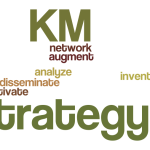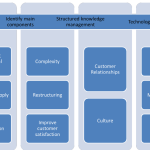Intellectual assets are generally categorized as human capital (like the know-how of knowledge workers that is “rented” by an organization), structural capital (like the policies, procedures, and applications that the organization “owns”), and customer or relationship capital (like the value of customer relationships and loyalty that has been built up over the years).
A variety of fairly sophisticated KM measurement techniques are available now that can help assess how well an organization is progressing. These involve benchmarking, the balanced scorecard method, and the house of quality matrix.
Before introducing any metric-based system, we have to be clear regarding what we want the metrics to answer. Metrics generally helps us to answer several questions, such as −
● Is Knowledge management working as required? And if not, what needs to be fixed?
● Is execution on track, and if not, what needs to be fixed?
● Are people doing what they are assigned to do? Who is doing well, who is not doing well?
● Are we delivering value? If we aren’t, let’s stop, or find a better way.
Measuring KM Implementation
The first thing to be done is probably wanting to measure, and how well we are managing to implement KM.
When we run your assessment at the start of KM implementation, we will develop some baseline metrics which you can measure the improvement against.
A KM assessment protocol measures various aspects of knowledge flow within an organization, and allows you to identify blockers and obstacles to knowledge flow. Rerunning the assessment later allows you to measure progress.
Measuring KM Compliance
Let us assume that an employee named Steve has introduced a knowledge management framework to the organization, with some clear accountabilities and clear expectations in the form of KM policies and standards.
At this stage, Steve might want to measure whether people are complying with these expectations, by using dashboarding and analytical tools to track his project members in an organization. Similar dashboards will be required in other functions of an organization.
Measuring KM Activity
It is also useful to introduce some activity based metrics to track different elements of your Knowledge management system.
Measuring Business Outcome
It is generally believed that, knowledge management leads to continuous performance improvement. As knowledge improves, so does the efficiency and results of an organization. Therefore, the more we deploy these methods and implement them, the better will be business performance.
Benchmarking
Benchmarking is the hunt for industry wide best practices that leads to superior performance. It is a fairly straightforward Knowledge Management metric that represents a good starting point.
Benchmarking basically consists of a study of similar companies to determine how things are done best in order to adapt these methods for their own use. This approach is best summed up by the Hindu proverb − “know the best to become the best.”
There are two general types of benchmarking −
● Internal benchmarking − Comparisons against other units within the same company or a comparison of a single unit over different time periods.
● External benchmarking − Comparison with other companies.
Balanced Scorecard
A Balanced Scorecard method (BSC) is a judgement and management system that enables enterprises to clarify their vision and strategy and which translates them into action. It offers feedback on both the internal business processes and external results in order to continuously improve strategic performance and results.
Balanced Scorecard is a conceptual framework for converting an organization’s vision into a set of performance indicators distributed among four dimensions −
● Financial Dimension − Involves measures such as operating income, return on capital employed, and economic value added.
● Customer Dimension − It is associated with such measures as customer satisfaction, retention, and market share in targeted segments.
● Internal Business Processes − Consists of measures such as cost, throughput, and quality.
● Learning and Growth − addresses measures such as worker’s satisfaction, retention, and skill sets.
Through BSC, an enterprise can monitor both its current performance (finances, customer satisfaction, and business process results) and its efforts to improve processes, motivate and educate employees, and enhance information systems − its ability to learn and improve.
The balanced scorecard method is applicable to both profitable and non-profitable enterprises as well as to both private and public sector companies. It provides a number of significant advantages, including the translation of abstract goals into action items that can be continuously monitored. In addition, the balanced scorecard method provides objective measures of the current scenario, and helps initiate the changes required to move from the current to the desired future state of the company.
The House of Quality Method
The house of quality method was discovered to show the links between true quality, quality characteristics, and process characteristics. It was done using the Fishbone Diagram, with true quality in the heads and quality and process features in the bones.

This technique was also known as Quality Function Deployment (QFD), as it links the customer’s needs with marketing, design, development, engineering, manufacturing, and service functions. It can be used for service as well as software products.
QFD is the only comprehensive quality system that aims specifically at satisfying the customer. It concentrates on maximizing customer satisfaction (positive quality), measured by metrics, such as repeat business and market share.
It focuses on delivering value by seeking out both spoken and unspoken needs, converting these into design targets, and communicating the targets throughout the organization.
In addition to this, it allows customers to prioritize their requirements, tells us how we are doing compared to our competitors, and then directs us to optimize those features that will bring the greatest competitive advantage.


